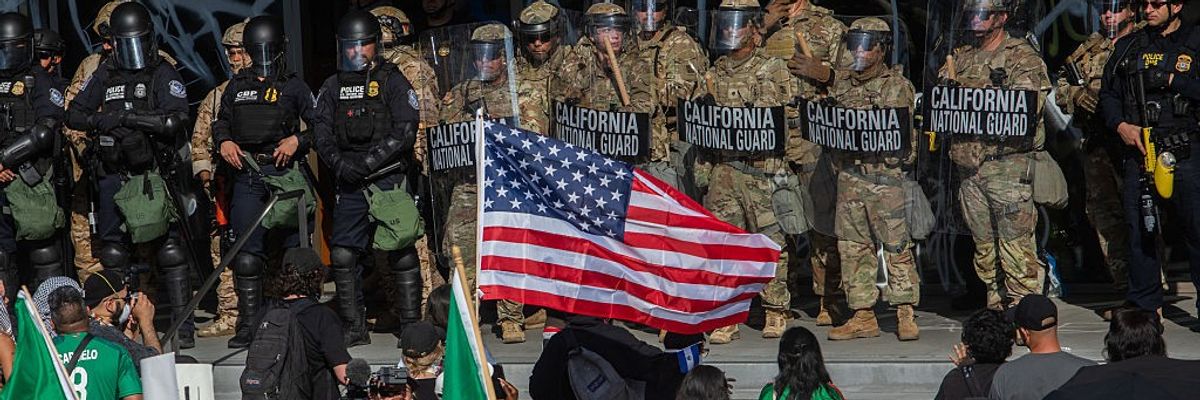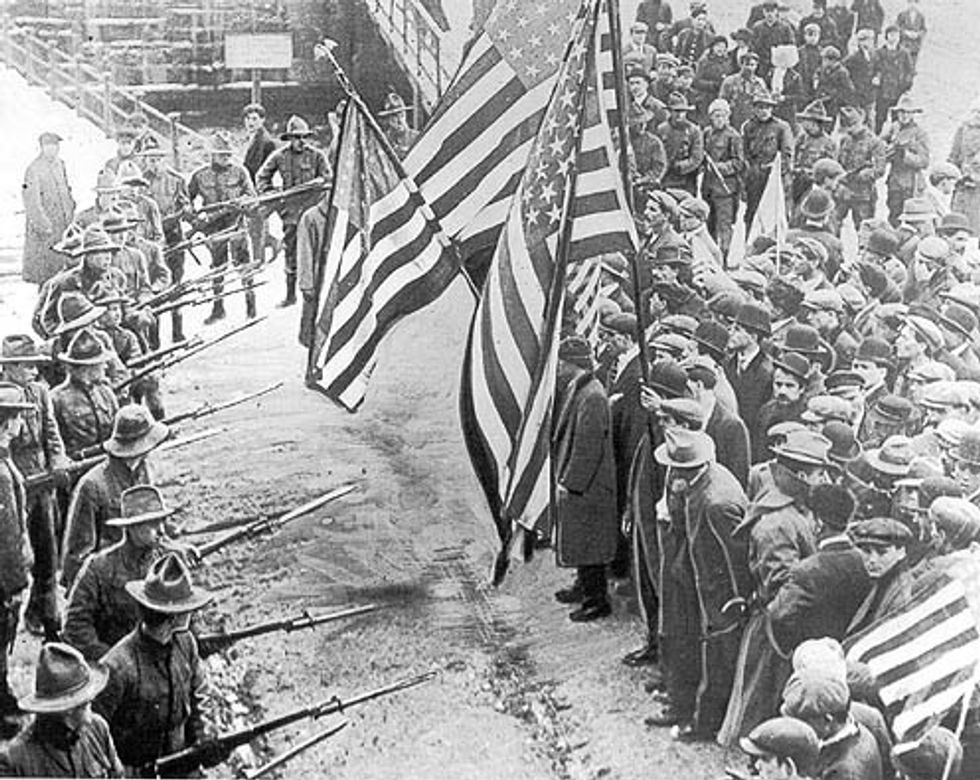
Demonstrators holding signs and flags face California National Guard members standing guard outside the Federal Building as they protest in response to federal immigration operations in Los Angeles, on June 9, 2025. (Photo by APU GOMES/AFP via Getty Images)
Reclaiming the Flag for No Kings Day
The flag represents the imperfect but essential mechanisms of democracy that Trump’s regime so profoundly threatens, ones that allow us to keep working for justice.
Will marchers carry flags on No Kings Day? In the wake of Trump sending the military into Los Angeles, it seems more important than ever.
On June 14, more than 1,800 local demonstrations will challenge U.S. President Donald Trump’s North Korean-style military parade for his birthday with our defense of democracy. The 14th is also Flag Day and the 250th anniversary of the Army. The flag can’t replace protest signs. But it complements and amplifies them.
The demonstrations send a message that even as Trump and his allies wrap themselves in their flags, they are betraying the best of America. They highlight a culture of corruption, where the only Americans who matter are allies of Trump at the top, and persons or institutions who would challenge this become subjects of attacks. Our flags make clear, in contrast, that we are defending Americans fundamental right to speak out, without which all other rights become meaningless. They’re a message to all who agree with us, but also to all those Americans who voted for Trump, or stayed home, rejecting both candidates. Because to change the direction of our country the support of at least some of these people will be essential.
Flags have long been part of the protest tradition, and may have even more impact when those speaking out are being marginalized or attacked.
As No Kings Day reminds us, “The flag doesn’t belong to Donald Trump. It belongs to us.” But at most anti-Trump protests, flags have been absent or marginal. I counted one when several thousand people marched in Seattle this past May Day, plus scattered Uncle Sam and Statue of Liberty images. That may be because carrying the flag feels uncomfortable, a false embrace for many who’ve marched to challenge American wars, call out racial injustice, or push back against corporate power. As a Korean-American activist once told a friend, “When you see other people waving their countries’ flags you think, ‘That’s nice, they love their country.’ When you see the American flag, you know people are going to die.” But the flag also stands for legacies of courage and sacrifice that should give us all hope, courage, and strength, like the classic World War II image of GI’s raising it over Iowa Jima.
The flag represents the imperfect but essential mechanisms of democracy that Trump’s regime so profoundly threatens, ones that allow us to keep working for justice. In defending these mechanisms and the rule of law, Thomas Jefferson condemned the very Alien and Sedition acts whose remnants Trump is now abusing. These acts created the power of kings, Jefferson warned, writing of threats to the “constitutional rights and liberties of the States and people… marked by the suspicions of the president, or be thought dangerous to his or their election, or other interests, public or personal.” These acts first targeted “the friendless alien,” Jefferson wrote, but “the citizen will soon follow.”
Flags have long been part of the protest tradition, and may have even more impact when those speaking out are being marginalized or attacked. American labor activists from the radical Industrial Workers of the World union carried them at the Lawrence Textile “bread and roses” strike. They fly next to Martin Luther King Jr. in photos from the 1963 March on Washington, and his talks at anti-war rallies. This year, demonstrators who helped defeat South Korean President Yoon Suk Yeol’s dictatorial power grab waved South Korean flags along with their signs.

Some recent anti-Trump rallies have featured them. But they need to become protest staples to help take the flag back. And when people fly them at home alongside signs or flags indicating where they stand on Trump and America’s direction, they amplify that message as well.
A recent Vietnam trip reminded me of the power of national pride. Americans are welcomed now, even as museums, statues, and street names commemorate heroes in what they call “the American war,” and the related fights against the Japanese and French occupations. But Vietnam also honors 13th, 15th, and 16th century kings who resisted and eventually defeated repeated invasions by the Chinese and Mongols. The country’s leadership could have dismissed them as the embodiment of now-discarded feudalism. Instead, they present their stories as part of a continuing story of resistance, a history they highlighted during the war as Ho Chi Minh and other leaders talked of fighting for their country, not communism. Whatever the limits of Vietnam’s current regime in terms of democracy, this worked because the roots of national patriotism ran deeper than any particular ideology.
The threat to American democracy that those of us marching address is internal, of course (with help from white foreign-born billionaires Elon Musk, Peter Thiel, and David Sacks). But the lesson of patriotism and national pride as a wellspring of resistance still holds true.
I’ve learned to appreciate those who bring flags to social justice protests. And I finally bought my own the other week at my local hardware store, to complement a “Don’t Putinize America” sign I plan to carry. The young woman at the counter’s initial look seemed to mark me, an older white man, as a likely Trump supporter. When I said I was buying it for the Trump protest, “No Kings Day,” she broke into a grin. Whatever our anger and disappointment about America failing to achieve much of what it should be, we need to defend what we have had and the possibility of what could be. Making the flag our own helps us do that.
An earlier version of this piece was published by the Fulcrum.
An Urgent Message From Our Co-Founder
Dear Common Dreams reader, The U.S. is on a fast track to authoritarianism like nothing I've ever seen. Meanwhile, corporate news outlets are utterly capitulating to Trump, twisting their coverage to avoid drawing his ire while lining up to stuff cash in his pockets. That's why I believe that Common Dreams is doing the best and most consequential reporting that we've ever done. Our small but mighty team is a progressive reporting powerhouse, covering the news every day that the corporate media never will. Our mission has always been simple: To inform. To inspire. And to ignite change for the common good. Now here's the key piece that I want all our readers to understand: None of this would be possible without your financial support. That's not just some fundraising cliche. It's the absolute and literal truth. We don't accept corporate advertising and never will. We don't have a paywall because we don't think people should be blocked from critical news based on their ability to pay. Everything we do is funded by the donations of readers like you. Will you donate now to help power the nonprofit, independent reporting of Common Dreams? Thank you for being a vital member of our community. Together, we can keep independent journalism alive when it’s needed most. - Craig Brown, Co-founder |
Will marchers carry flags on No Kings Day? In the wake of Trump sending the military into Los Angeles, it seems more important than ever.
On June 14, more than 1,800 local demonstrations will challenge U.S. President Donald Trump’s North Korean-style military parade for his birthday with our defense of democracy. The 14th is also Flag Day and the 250th anniversary of the Army. The flag can’t replace protest signs. But it complements and amplifies them.
The demonstrations send a message that even as Trump and his allies wrap themselves in their flags, they are betraying the best of America. They highlight a culture of corruption, where the only Americans who matter are allies of Trump at the top, and persons or institutions who would challenge this become subjects of attacks. Our flags make clear, in contrast, that we are defending Americans fundamental right to speak out, without which all other rights become meaningless. They’re a message to all who agree with us, but also to all those Americans who voted for Trump, or stayed home, rejecting both candidates. Because to change the direction of our country the support of at least some of these people will be essential.
Flags have long been part of the protest tradition, and may have even more impact when those speaking out are being marginalized or attacked.
As No Kings Day reminds us, “The flag doesn’t belong to Donald Trump. It belongs to us.” But at most anti-Trump protests, flags have been absent or marginal. I counted one when several thousand people marched in Seattle this past May Day, plus scattered Uncle Sam and Statue of Liberty images. That may be because carrying the flag feels uncomfortable, a false embrace for many who’ve marched to challenge American wars, call out racial injustice, or push back against corporate power. As a Korean-American activist once told a friend, “When you see other people waving their countries’ flags you think, ‘That’s nice, they love their country.’ When you see the American flag, you know people are going to die.” But the flag also stands for legacies of courage and sacrifice that should give us all hope, courage, and strength, like the classic World War II image of GI’s raising it over Iowa Jima.
The flag represents the imperfect but essential mechanisms of democracy that Trump’s regime so profoundly threatens, ones that allow us to keep working for justice. In defending these mechanisms and the rule of law, Thomas Jefferson condemned the very Alien and Sedition acts whose remnants Trump is now abusing. These acts created the power of kings, Jefferson warned, writing of threats to the “constitutional rights and liberties of the States and people… marked by the suspicions of the president, or be thought dangerous to his or their election, or other interests, public or personal.” These acts first targeted “the friendless alien,” Jefferson wrote, but “the citizen will soon follow.”
Flags have long been part of the protest tradition, and may have even more impact when those speaking out are being marginalized or attacked. American labor activists from the radical Industrial Workers of the World union carried them at the Lawrence Textile “bread and roses” strike. They fly next to Martin Luther King Jr. in photos from the 1963 March on Washington, and his talks at anti-war rallies. This year, demonstrators who helped defeat South Korean President Yoon Suk Yeol’s dictatorial power grab waved South Korean flags along with their signs.

Some recent anti-Trump rallies have featured them. But they need to become protest staples to help take the flag back. And when people fly them at home alongside signs or flags indicating where they stand on Trump and America’s direction, they amplify that message as well.
A recent Vietnam trip reminded me of the power of national pride. Americans are welcomed now, even as museums, statues, and street names commemorate heroes in what they call “the American war,” and the related fights against the Japanese and French occupations. But Vietnam also honors 13th, 15th, and 16th century kings who resisted and eventually defeated repeated invasions by the Chinese and Mongols. The country’s leadership could have dismissed them as the embodiment of now-discarded feudalism. Instead, they present their stories as part of a continuing story of resistance, a history they highlighted during the war as Ho Chi Minh and other leaders talked of fighting for their country, not communism. Whatever the limits of Vietnam’s current regime in terms of democracy, this worked because the roots of national patriotism ran deeper than any particular ideology.
The threat to American democracy that those of us marching address is internal, of course (with help from white foreign-born billionaires Elon Musk, Peter Thiel, and David Sacks). But the lesson of patriotism and national pride as a wellspring of resistance still holds true.
I’ve learned to appreciate those who bring flags to social justice protests. And I finally bought my own the other week at my local hardware store, to complement a “Don’t Putinize America” sign I plan to carry. The young woman at the counter’s initial look seemed to mark me, an older white man, as a likely Trump supporter. When I said I was buying it for the Trump protest, “No Kings Day,” she broke into a grin. Whatever our anger and disappointment about America failing to achieve much of what it should be, we need to defend what we have had and the possibility of what could be. Making the flag our own helps us do that.
An earlier version of this piece was published by the Fulcrum.
- America’s Safety Is Fragile; Trump Is Tearing Down the Systems That Protect It ›
- This Is How Trump Kills US Democracy—With US Marines in the Street ›
- Trump Orders US Military to Plan Invasion of Panama to Seize Canal: Report ›
- Reclaiming Democracy from Capitalism: Understanding Trump's Resurgence ›
- Opinion | Before the Dust Settles: A Strategy for Reclaiming the People's House | Common Dreams ›
Will marchers carry flags on No Kings Day? In the wake of Trump sending the military into Los Angeles, it seems more important than ever.
On June 14, more than 1,800 local demonstrations will challenge U.S. President Donald Trump’s North Korean-style military parade for his birthday with our defense of democracy. The 14th is also Flag Day and the 250th anniversary of the Army. The flag can’t replace protest signs. But it complements and amplifies them.
The demonstrations send a message that even as Trump and his allies wrap themselves in their flags, they are betraying the best of America. They highlight a culture of corruption, where the only Americans who matter are allies of Trump at the top, and persons or institutions who would challenge this become subjects of attacks. Our flags make clear, in contrast, that we are defending Americans fundamental right to speak out, without which all other rights become meaningless. They’re a message to all who agree with us, but also to all those Americans who voted for Trump, or stayed home, rejecting both candidates. Because to change the direction of our country the support of at least some of these people will be essential.
Flags have long been part of the protest tradition, and may have even more impact when those speaking out are being marginalized or attacked.
As No Kings Day reminds us, “The flag doesn’t belong to Donald Trump. It belongs to us.” But at most anti-Trump protests, flags have been absent or marginal. I counted one when several thousand people marched in Seattle this past May Day, plus scattered Uncle Sam and Statue of Liberty images. That may be because carrying the flag feels uncomfortable, a false embrace for many who’ve marched to challenge American wars, call out racial injustice, or push back against corporate power. As a Korean-American activist once told a friend, “When you see other people waving their countries’ flags you think, ‘That’s nice, they love their country.’ When you see the American flag, you know people are going to die.” But the flag also stands for legacies of courage and sacrifice that should give us all hope, courage, and strength, like the classic World War II image of GI’s raising it over Iowa Jima.
The flag represents the imperfect but essential mechanisms of democracy that Trump’s regime so profoundly threatens, ones that allow us to keep working for justice. In defending these mechanisms and the rule of law, Thomas Jefferson condemned the very Alien and Sedition acts whose remnants Trump is now abusing. These acts created the power of kings, Jefferson warned, writing of threats to the “constitutional rights and liberties of the States and people… marked by the suspicions of the president, or be thought dangerous to his or their election, or other interests, public or personal.” These acts first targeted “the friendless alien,” Jefferson wrote, but “the citizen will soon follow.”
Flags have long been part of the protest tradition, and may have even more impact when those speaking out are being marginalized or attacked. American labor activists from the radical Industrial Workers of the World union carried them at the Lawrence Textile “bread and roses” strike. They fly next to Martin Luther King Jr. in photos from the 1963 March on Washington, and his talks at anti-war rallies. This year, demonstrators who helped defeat South Korean President Yoon Suk Yeol’s dictatorial power grab waved South Korean flags along with their signs.

Some recent anti-Trump rallies have featured them. But they need to become protest staples to help take the flag back. And when people fly them at home alongside signs or flags indicating where they stand on Trump and America’s direction, they amplify that message as well.
A recent Vietnam trip reminded me of the power of national pride. Americans are welcomed now, even as museums, statues, and street names commemorate heroes in what they call “the American war,” and the related fights against the Japanese and French occupations. But Vietnam also honors 13th, 15th, and 16th century kings who resisted and eventually defeated repeated invasions by the Chinese and Mongols. The country’s leadership could have dismissed them as the embodiment of now-discarded feudalism. Instead, they present their stories as part of a continuing story of resistance, a history they highlighted during the war as Ho Chi Minh and other leaders talked of fighting for their country, not communism. Whatever the limits of Vietnam’s current regime in terms of democracy, this worked because the roots of national patriotism ran deeper than any particular ideology.
The threat to American democracy that those of us marching address is internal, of course (with help from white foreign-born billionaires Elon Musk, Peter Thiel, and David Sacks). But the lesson of patriotism and national pride as a wellspring of resistance still holds true.
I’ve learned to appreciate those who bring flags to social justice protests. And I finally bought my own the other week at my local hardware store, to complement a “Don’t Putinize America” sign I plan to carry. The young woman at the counter’s initial look seemed to mark me, an older white man, as a likely Trump supporter. When I said I was buying it for the Trump protest, “No Kings Day,” she broke into a grin. Whatever our anger and disappointment about America failing to achieve much of what it should be, we need to defend what we have had and the possibility of what could be. Making the flag our own helps us do that.
An earlier version of this piece was published by the Fulcrum.
- America’s Safety Is Fragile; Trump Is Tearing Down the Systems That Protect It ›
- This Is How Trump Kills US Democracy—With US Marines in the Street ›
- Trump Orders US Military to Plan Invasion of Panama to Seize Canal: Report ›
- Reclaiming Democracy from Capitalism: Understanding Trump's Resurgence ›
- Opinion | Before the Dust Settles: A Strategy for Reclaiming the People's House | Common Dreams ›

